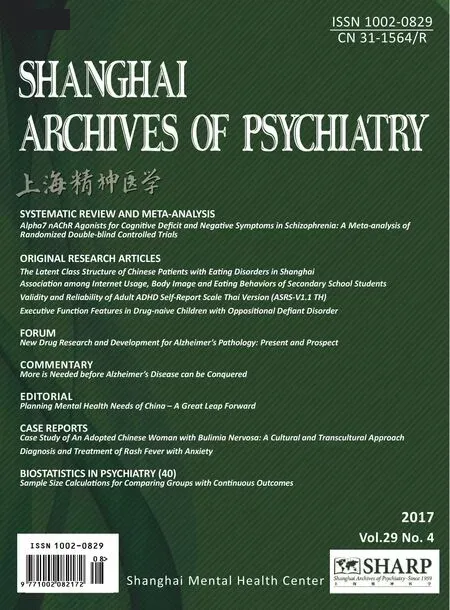Diagnosis and Treatment of Rash Fever with Anxiety
Yueyun ZHU
•CASE REPORT•
Diagnosis and Treatment of Rash Fever with Anxiety
Yueyun ZHU
Rash, fever, Yin Deficiency
1. Medical history
1.1 Patient
A 40-year-old female patient was admitted to our hospital with symptoms of paroxysmal chills, hot flashes,fatigue, anorexia and insomnia that had persisted for more than two months. During the past two months,the patient often experienced a sudden feeling of chills and fever with unknown causes despite normal body temperature, she reported a burning sensation,especially on her palms, and liked touching cool objects to relieve this burning sensation. In addition, the patient also reported insomnia, night sweats, and red rashes on the inside of her arms. These rashes did not cause itchiness and disappeared when pressed on or after about half an hour. There were intervals where all of these symptoms would also completely disappear. Other symptoms included fatigue, anorexia and weight loss(about 5 kg). Menstruation was normal over these two months. The patient was admitted to the Department of dermatology, endocrinology, traditional Chinese medicine, rheumatology and immunology at several large hospitals, but her condition did not improve.
1.1.1 Past Medical History
The patient had previously been in good health with no reported history of hepatitis, tuberculosis, hypertension,and diabetes. She also reported no history of blood transfusion or food allergy. She had surgery related to her appendicitis about 6 months prior. The patient had received all the recommended vaccinations. Prior to the appearance of these symptoms the patient did not take any medications.
1.1.2 Personal history
The patient is a resident of Nantong City (Jiangsu Province, China). She reported no history of alcoholism or smoking. She did not have contact with contaminated water.
1.1.3 Obstetric history
The patient was at an appropriate age when married and reported that family relationships were harmonious. Her husband and child were healthy.The patient reported regular menstruation and no menstrual cramps. She gave birth to a son by caesarean section. There was no history of hereditary diseases in the family.
1.1.4 Physical examination
Upon physical examination, the patient’s temperature was 36.5°C and blood pressure was 110/78mmHg.Heart rate was regular at 92 beats/min. Respiratory rate was 18 breaths/min and with normal breath sounds.During the medical examination, the patient was clearly anxious. She showed signs of sallow complexion,tremor in both arms, faster speech rate but responses were still relevant to the discussion topics. The patient developmental level was normal and she maintained a normal diet. There were no signs of abdominal, liver, or spleen abnormalities upon physical examination.
1.1.5 Laboratory examination:
The patient was admitted to the department of dermatology, endocrinology, traditional Chinese medicine, rheumatology and immunology at several large hospitals. She received the following diagnostic tests: routine blood test, renal and liver function,autoantibody spectrum, a full set of immune index tests,and thyroid functioning. The results showed a slightly decreased immunoglobulin M level, a slightly elevated immunoglobulin level, and weakly positive antiSSA and antiCENPB antibody levels. All other indices were within normal limits.
The patient was prescribed oral oryzanol,multivitamin B tablets and acanthopanax senticosus.In addition to western medicine, the patient also received traditional Chinese medicine and concurrent acupuncture treatment. According to traditional Chinese medicine, the patient was diagnosed with a yin deficiency, she was prescribed Atractylodes rhizome, raw gardenia, Rhizoma Chuanxiong, radix paeoniae rubra, Cyperus rotundus, paeonol, comfrey,raw rehmannia, Anemarrhena, phellodendron, Radix Bupleuri, artemisinin annua and other medications,which she took for two months.
Acupuncture treatment (6 times, 30 minutes) did not result in any improvements. A literature review found that Western medicine as well as the Traditional Chinese Medicine were both ineffective in treating this type of medical condition.
1.2 Methods
Over the two months of treatment that the patient received she did not see any improvement in symptoms.Therefore we conducted a clinical interview to understand if there were any underlying psychosocial factors contributing to her condition. During the interview the client reported the recent deaths of several relatives, a stressful work environment,worry over her child’s education and stress related to management of the household.
Based on the interview and careful consideration we believed that the patient was suffering from autonomic dysfunction and somatic discomfort related to her prominent anxiety.
Although the physical examination did not find any abnormal results, the patient complained about elevated heart rate, sweating, muscle tension, hand tremors, restlessness, nervousness, fatigue, and disordered sleep. These symptoms supported a diagnosis of an anxiety-related disorder. Based on this diagnosis, the patient was prescribed Sertraline(Xi Tongjing), 50 mg to be taken orally once a day. The patient also received psychological counseling.
1.3 Results
Administrating Sertraline at a higher dose significantly relieved the symptoms of sweating, and fatigue. She recovered weight she had lost, had improved sleep and significantly less anxiety within half a month. After one month’s treatment, the patient’s symptoms completely disappeared and her physiological state returned to normal.
The patient’s positive response to Sertraline treatment seemed to confirm the diagnosis of an anxiety-related condition. The average length of treatment for anxiety disorders is 1-2 years. This patient was treated for about a year and a half and was initially prescribed 50mg of Sertraline to be taken every two days. However, because she still had mild symptoms under that dosage she was later switched to 50mg every day. This change in dosage did not result in any discomfort or side effects.
2. Discussion
There has been an increase in anxiety disorders due the fast pace of life and stress in society.[1]Anxiety disorders can affect both the physical and mental health of individuals, and can negatively impact work and social life. Therefore, the proper diagnosis and timely treatment is critical. Anxiety disorders result from hyperactivity in the sympathetic and parasympathetic nervous systems, often accompanied by excessive release of epinephrine and norepinephrine. Balance of sympathetic and parasympathetic function determines the patient’s somatic symptoms.[2]Anxiety disorders can also cause autonomic nervous system disorders,resulting in a variety of physical changes. Various somatic diseases with unknown causes, such as, fever,night sweats, fatigue, insomnia, weight loss and hand tremors, manifest from overactivity of the autonomic nervous system. For autonomic nervous system disorder that do not respond to conventional treatment, a clinical interview can be considered to rule out any psychosocial factors that may be influencing the individual’s health.If indeed it is found that significant anxiety symptoms are present than pharmacological and psychosocial interventions can be considered to help the patient quickly return to normal functioning.
Funding statement
No funding was obtained for the writing of this report.
Conflict of interest statement
Author declares no conflict of interest related to this report.
Informed consent
Written informed consent was obtained from the patient and written permission was obtained to publish this report.
1. Yang CX. [Clinical analysis with Chinese medical theory on syndrome manifestations of anxiety disorders]. Xian Dai Zhong Yi Lin Chuang. 2006; 13(1): 4-7. Chinese. doi: http://dx.chinadoi.cn/10.3969/j.issn.1672-2205.2006.01.002
2. Luo SY. [Analysis of Depression and Anxiety Symptoms and Its Affected Factors in Perimenopausal Women]. Hunan,Changsha: Central South University; 2010. Chinese
一例带有出疹发热的焦虑症的诊断与治疗
朱岳云
概述:一住院患者症状为每日不定时出疹,自觉发热、乏力,夜间盗汗、失眠,通过运用常规的检测和治疗方法,患者症状基本没有改善。本文通过介绍一种成功治疗案例,以供大家今后针对该类病患的治疗参考。
出疹,发热,阴虚,焦虑症,抗焦虑类药物
Summary: A patient was admitted to our hospital with irregular rash, fever, fatigue, night sweats, and insomnia. The patient’s condition showed no improvements with routine testing and treatments. In this paper, a successful treatment is presented for future therapeutic reference of this type of patient.
[Shanghai Arch Psychiatry. 2017; 29(4): 247-249.
http://dx.doi.org/10.11919/j.issn.1002-0829.216103]
Sian Health Clinics, Tongzhou District, Nantong, Jiangsu Province, China
correspondence: Yueyun Zhu. Mailing address: Sian health clinics, Tongzhou District, Nantong, Jiangsu Province, China. Postcode: 226351. E-Mail:jmh156@sohu.com

Yueyun Zhu graduated from Nanjing Medical University in 2004. She has been working in (and is currently director of) the internal medicine unit of the Sian Health Center in Nantong (Jiangsu Province, China) since 1996. Her research interests include internal medicine and general medicine.
- 上海精神医学的其它文章
- Sample Size Calculations for Comparing Groups with Continuous Outcomes
- Case Study of An Adopted Chinese Woman with Bulimia Nervosa: A Cultural and Transcultural Approach
- Planning Mental Health Needs of China – A Great Leap Forward
- More is Needed before Alzheimer’s Disease can be Conquered
- New Drug Research and Development for Alzheimer’s Pathology:Present and Prospect
- Executive Function Features in Drug-naive Children with Oppositional Defiant Disorder

